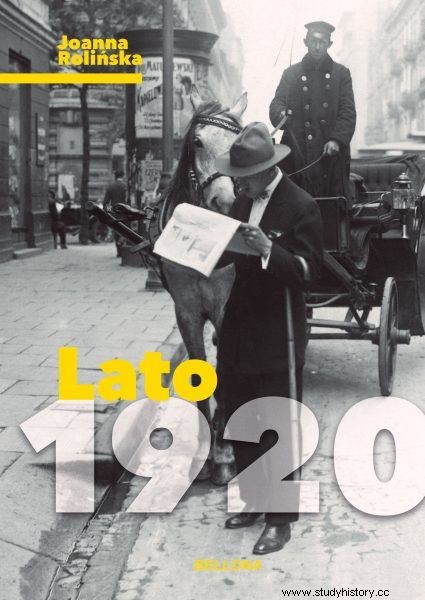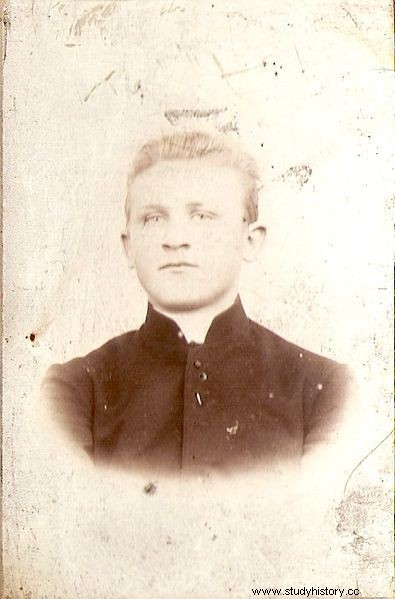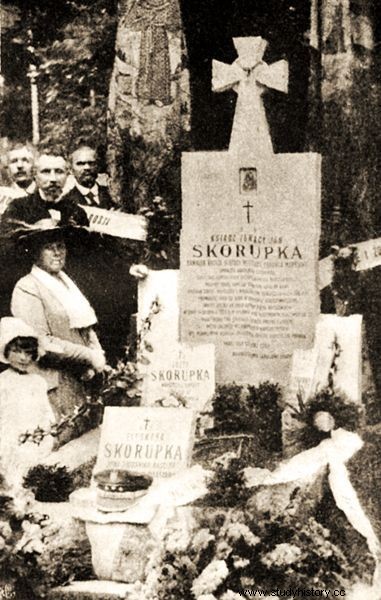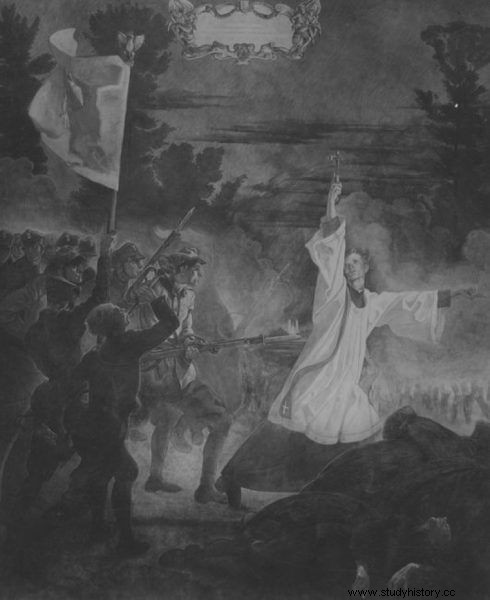Father Ignacy Skorupka heroically died in the battle of Ossów. His death became one of the most important symbols of the Battle of Warsaw and fit into the idea of the so-called "Miracle on the Vistula". What were the funeral ceremonies like and how was the legend born?
The funeral ceremonies of the young priest in Warsaw attracted real crowds. General Józef Haller, the Commander-in-Chief of the Northern Front, who posthumously awarded the priest with the Order of Virtuti Militari, appeared in person. Almost immediately around the tragic death of Ignacy Skorupka, a legend began to form that survived to our times. It was his sacrifice that became one of the most important symbols of "18. the most important battle in the history of the world ”.
Young priest
Ignacy Skorupka was born in 1893 in Warsaw. He was the firstborn son of a Warsaw magistrate who supervised the Praga market. He studied at a philological gymnasium, and then entered the Warsaw Theological Seminary . He was undoubtedly a hard worker. In the book Joanna Rolińska Summer 1920 we get acquainted with clippings from Warsaw newspapers. On the occasion of the tragic death of the young clergyman, his profile was brought up:
Apparently, there is a certain percentage of German blood in the Skorupek family. This is where [...] my passion for regularity and punctuality arose. […] Fr. Skorupka loved Warsaw with an undivided love. He knew its beauty and was able to talk about the charms of Warsaw alleys in a touching way. […] It was a young, handsome, blond man with bright, expressive eyes. People clung to him. He had something nice, something captivating in his form. […]

The article was inspired by Joanna Rolińska's book Lato 1920 , which has just been released on the market by Bellona
Young Ignacy continued his career in Petrograd at the Theological Academy, which, however, he did not complete due to family problems. As a priest, he was active in various parts of Russia, and additionally he was involved in social activities, organizing educational and cultural institutions. After returning to Poland, he became the founder and president of the "Education" Society, then he worked as a notary and archivist at the Warsaw Metropolitan Curia, he was involved in helping orphans, he was also the commander of the Lodz ZHP regiment.
Motherland is calling
The young priest immediately became involved in the defense of the capital. He volunteered for the army and, despite his initial refusal, he became the chaplain of the Prague garrison, and then (again at his own request) he was appointed the flight chaplain of the 1st battalion of the 236th infantry regiment of the Volunteer Army.
The battalion moved to the front on August 13, 1920. The next day the young chaplain was already dead…
On August 16, 1920, Warsaw newspapers wrote about his heroic death at the front. The first article on this subject is quoted by Joanna Rolińska in the pages of the book Lato 1920:
One of the first victims of duty [...] fell on 13 May. late Fr. Ignacy Skorupka, prefect of Warsaw schools, archivist of the metropolitan curia, leading a regiment of volunteers with a cross to the front line near Radzymin. He died from the Bolshevik bullet. His death in the field of glory testifies eloquently to the world about the cordial agreement between the Polish orthodox people. And the Polish national clergy. This death maintains the knightly tradition of fighting for our freedom, in which the hand of the priests always carried banners with the slogan:"God and fatherland", leading the people to victories [...]

Ignacy Skorupka in 1907
On the following pages we can also see another press about the priest's heroic death:
[...] volunteer chaplain of the 236th regiment of Polish army volunteers, after short but severe suffering, he died on August 14 from bullets inflicted by the enemy, and then pierced several times with a bayonet on the battlefield near Ossów, with Rembertów, leading with a cross in his hand and a song on the lips of "Cordial Mother", a battalion of school youth volunteers to fight, who lived only 27 years of age. [...]
The literary descriptions of the chaplain's death were not true, but they perfectly matched the emerging myth of the "miracle on the Vistula River". Father Skorupka was in fact killed while giving the last rites to one of his soldiers. Of course, this does not diminish the heroism of the volunteer priest!
On that day, a collective obituary was also published in the press, in which the dead on the same day were remembered:
On August 14, in the fight for Warsaw, they died a heroic death:the late Helena Szybowska née Szvygielska, late Fr. chaplain Ignacy Skorupka, late Lieutenant Stanisław Matarewicz, commander of the l.236 infantry regiment, late Zygmunt Płoszko. The removal of the bodies from the Ujazdowski Hospital on August 17, r. At 3 p.m., as notified by the command of 236 pp.
Funeral ceremonies
The priest's body was transported to Warsaw and the funeral ceremonies took place on August 17 in a completely full church on Długa Street. It was a ceremony during which Captain Ryszard Downar-Zapolski and Officer Cadet Lachowicz were also bid farewell. None of the deceased lived to see their 30th birthday…
The funeral ceremonies were reported in Kurjer Warszawski. We can read their course in the book Summer 1920 :
Coffins strewn with flowers with the bodies of the heroes, faces flooded with tears, marked with deep regret, countless crowds on the sidewalks and roads ... A silent female sob is mixed with mourning singing and the melody of Mazurek Dąbrowski played by a military orchestra. Lots of clergy headed by Bishop Gall, military authorities headed by General Haller, civil authorities, city commandant's office.

The grave of Ignacy Skorupka
During the funeral, canon Antoni Szlagowski and gen. Józef Haller, who announced that by the order of the Commander-in-Chief, Father Ignacy Skorupka and Captain Zapolski were awarded the Order of Virtuti Militari 5th Class . At the same time, the general called on the people of Warsaw to "abandon thoughtlessness and sobekness and stand next to the soldier with his breasts covering his country and capital with his breasts." Haller's fiery speech went down in history:
Poles! Look within yourself! Give at least a dedicated work for Poland, for which those to whom we express our veneration here today sacrificed their lives, bearing witness that Poland did not perish and cannot perish! Let's follow their lead! Poland and in the future can only survive as a watchful and armed camp of sacrificial and vigilant people.
At noon, the funeral procession moved to Powązki.
Priest - legend
Father Skorupka's legend began to develop almost immediately. It fit perfectly with the specific myth of the "miracle on the Vistula River". The solemn entry appeared in Robotnik:
[...] Did he stop living? No, he started to live. It began and will continue forever, just like those Polish priests from the time of the last uprising, almost all of them. They awakened the national spirit, they went with the insurgent parties and conquered and died with them. And their memory remains in the nation. This will be the memory of Father Skorupka. [… ] in a tender memory he will keep [the nation - ed. ed.] a great figure of a hero in a cassock, who for an hour shone like a precious diamond on the battlefield and left.

Jan Henryk Rosen's painting "The Death of Father Skorupka"
Also the Illustrated Weekly Magazine "Świat" wrote more about his sacrifice. The priest's biography was recalled in detail and his love for the homeland was emphasized:
[...] He wanted to be in line with the junior high school students, of which he was the prefect. […] He was loved by young people. [...] Apparently, Fr. Skorupka led his battalion four times. [...] he was shot in the head with an ecrasite bullet. Death had to be immediate. The Bolsheviks stabbed him with their bayonets. […]
Going into the field with his battalion, Ignacy Skorupka had to reckon with death. He even prepared a will. As we read in the book Summer 1920 :
He wrote a will before going to the […] field. He gave out in detail what he had to give. Personally, he even tied the books with string and affixed the names of his heirs.
The figure of the heroic priest ignited the imagination and spread wider and wider circles. According to some, it was supposed to be a harbinger of the aforementioned "miracle" that turned the fate of the Polish-Bolshevik war. His silhouette appeared in many paintings (including by Jerzy Kossak and Jan Henryk Rosen), as well as on commemorative postcards. She also appeared in literature and a few years ago in film.

The article was inspired by Joanna Rolińska's book Lato 1920 , which has just been released on the market by Bellona
The priest was posthumously awarded the Star of Perseverance and the Order of the White Eagle.
Today, historians are rather unanimous that there can be no question of a "miracle". The Polish victory in the battle with the Bolsheviks was to be determined by an excellent operational plan, a maneuver flanking the Red Army led by Piłsudski and a counteroffensive from the Wieprz River. Regardless of the terminology, however, many volunteers, such as Father Ignacy Skorupka, died during the military operations, and it was their sacrifice that stopped the "red" offensive and changed the fate of not only Poland, but also Europe.
